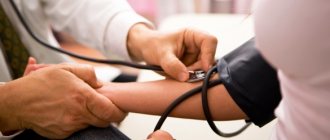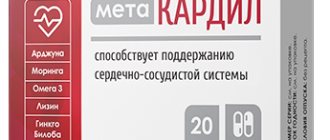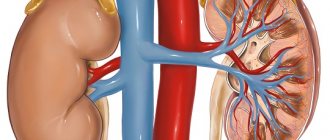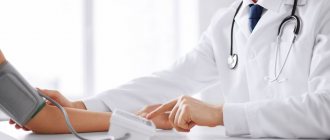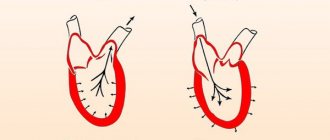Old age is a wonderful time in a person’s life. However, it is associated with multiple ailments, ailments and other health problems. Some of them can be avoided by leading a correct lifestyle, some can be prevented, some can be cured, and others can only be corrected with the help of medications.
Today's article will focus on the problem of high blood pressure and low pulse in an elderly person. We will look at the accompanying symptoms of illness, how to provide first aid, and in general, what to do if such a phenomenon occurs.
What indicators are considered normal?
Before starting treatment for high blood pressure (BP) and low heart rate, it is helpful to become familiar with your normal heart rhythm. Most experts believe that a normal heart rate is 65-85 beats per minute.
This is the heart rate that occurs in many adults. To make sure there are no problems with your heartbeat, pay attention to the time intervals between beats.
If the heart beats at the same time, then the person has no problems with the pulse rate. An excessively rapid heartbeat or long intervals between beats indicate the development of arrhythmias.
The value of normal blood pressure is influenced by various factors, the most important of which are gender and age. A rapid heartbeat is considered normal for babies in the first few months of their life. In this case, the heart rate reaches 135 beats per minute. Within a year, this value drops to one hundred strokes, and after three years - to 95.
By puberty, the heart rate in adults decreases to normal. These changes are due to the fact that during childhood and adolescence, the heart works harder to saturate the body with blood. At the age of 35-40 years, the heart rate gradually increases to 80 beats per minute. In older people aged approximately 60-70 years, this figure increases to 90 heart beats.
Symptoms that require seeing a doctor or calling an ambulance
The list of life- and health-threatening symptoms is quite wide. It is necessary to consult a doctor in any unclear situation; there is no need to be embarrassed about it. False installations can be very expensive.
Among the manifestations that should alert you are:
- Headache of any location and degree of intensity. This is a dangerous manifestation. Indicates a violation of vascular tone and blood circulation.
- Dizziness. Especially of a regular nature. Associated with an attack of bradycardia and arterial hypertension.
- Impaired consciousness. Confusion, inability to think normally. It is dangerous because it indicates an acute cerebrovascular accident.
- Chest pain. They give it to the back and hands.
- Shortness of breath, breathing problems.
- Feeling of unreasonable fear, panic attack.
- Pulse less than 50 beats per minute, weakness, drowsiness, fatigue and a significant decrease in performance even in the morning.
This is only a small part of the manifestations. Others are also possible. In all doubtful cases, you should consult a doctor. This is an axiom that must be remembered.
Deviation from the norm
Each person's heart rate should be within normal limits. However, sometimes heart rate fluctuations exceed the established limits, which leads to deterioration of health. This problem occurs for various reasons. Among them there are pathological and physiological.
The latter are considered the safest, since in this case the pulse returns to normal after half an hour. The most dangerous are pathological factors that cause heart rhythm disturbances, because they are associated with various diseases.
Physiological and pathological factors lead to the following cardiac contraction disorders:
- Increased heart rate. An increase in heart rate to one hundred beats leads to the development of tachycardia. This pathology appears as a result of infectious diseases and abnormalities in the structure of the heart. In rare cases, tachycardia develops with a tumor. If you experience heart palpitations, it is better to consult a doctor to find out the exact cause of the problem.
- Low heart rate. A heart rate less than 60 beats per minute is called bradycardia and can be pathological or functional. Pathological leads to a constant decrease in heart rate, and due to functional heart rate it drops only in the evening.
Causes of low heart rate with high blood pressure
The development of hypertension with a rare pulse is explained by a large group of heterogeneous causes. What factors are most common?
Hypothyroidism
In other words, a reduced concentration of thyroid hormones in the bloodstream. Always provokes the formation of a low heart rate.
In some cases, it also causes an increase in blood pressure to insignificant levels (140-150 mmHg). Ultrasound diagnostics and laboratory research methods will help put an end to the issue.
Development of persistent bleeding
With minimal volume of hematological fluid leakage. Among the factors in the development of such a problem: stomach ulcers, duodenal ulcers, Crohn's disease and other pathologies.
They are associated with anemia, when the body does not have enough iron. As a result, cardiac activity and regulatory processes in the body suffer.
Diseases of the brain and cerebral structures
Meningitis (inflammatory process), tumors of various locations in the brain, hematomas as a result of traumatic brain injury.
Stimulation of special centers responsible for regulating vascular tone throughout the body occurs, and the normal heart rhythm is disrupted - which is why the pulse is low with high blood pressure.
Pressure on the eyes
Vagal maneuver is used, among other things, to lower blood pressure as a first aid measure and diagnostic method. If there are no ophthalmological pathologies.
It consists of a sharp drop in heart rate due to mechanical impact on the eyeballs, the so-called Aschner reflex. It is not pathological in nature.
Mechanical effect on the carotid sinus
For example, when strangling, wearing a tight collar or tie. The sinus is located in the area of the carotid artery.
When an anatomical structure is compressed, the heart rate is disrupted, and the pressure can either increase or decrease.
Neurotic pathologies with severe autonomic dysfunction
Autonomic dysfunction occurs mainly in patients with a special personality type. Usually these are representatives of the weaker sex, emotionally labile. Less often - young men.
Such neurotic manifestations require complex treatment by both a neurologist and a psychotherapist.
Impaired blood circulation and hemodynamics in the brain
As a result of the course of pathologies, from cervical osteochondrosis to vertebrobasilar insufficiency, the pressure may rise and the pulse may decrease.
Diseases of this kind seem harmless only at first glance. Everything can end badly, including a stroke.
Conduction disorders in the myocardium
Accompanied by constant bradycardia without the ability to help with classical medication methods. All types of heart blocks are described in this article.
Inflammation of cardiac structures
Up to myocarditis, endocarditis and destruction of the atria or ventricles as a result of infectious diseases.
Myocardial infarction
During the acute course of the disease and immediately after, in the first 6 months, bradycardia against the background of mild hypertension is considered an acceptable phenomenon.
We may be talking about a physiological combination of hypertension and bradycardia. More often, a similar situation is observed among professional athletes who literally push their own body.
The heart beats at a rate of 35-60 beats per minute even during physical activity. A slow pulse is normal. The body is constantly in a state of high alert.
It is interesting to note that professional athletes are more susceptible to cardiac arrest, heart attack and heart failure during periods of non-physical activity (the cardiovascular system gets used to overload).
Each specific case needs to be examined separately.
Factors affecting blood pressure
Reasons why people have a low heart rate include problems with blood pressure levels. Therefore, it is important to understand the main factors that influence a person's blood pressure.
Excess weight
Some people develop high blood pressure due to poor diet and obesity. Excess weight increases the load on the body, which leads to problems with the functioning of the heart vessels and other organs responsible for blood circulation. To eliminate hypertension caused by obesity, you will need to change your diet and lose excess weight.
Alcohol
Alcohol abuse negatively affects blood pressure and provokes the development of heart pathologies. It also disrupts the functioning of the nervous system, which impairs blood circulation. To minimize the risk of a heart attack and other dangerous pathologies, you should limit yourself to 50 milliliters per day or completely abstain from alcoholic beverages.
Stressful situations
Regular depression along with stress increases the likelihood of developing high blood pressure. Therefore, to avoid this pathology, it is recommended to avoid stressful situations.
Physical inactivity
Physical inactivity is also one of the factors affecting blood pressure. This pathology reduces muscle tension and leads to weakening of the body. Physical inactivity also causes weight gain and obesity, which also leads to increased blood pressure.
List of necessary examinations for bradycardia due to hypertension
Both the heart and blood vessels are examined. There can be many factors in the development of processes. First of all, you should contact a cardiologist.
If necessary, he will refer the patient to a neurologist or endocrinologist. The complexity and duration of the examination depends on the nature of the disease and the complexity of the situation.
In general, the list of studies looks like this:
- Initial consultation, conversation with the collection of characteristic complaints and anamnestic data. Plays a big role, this is the first step in identifying the root cause of the condition.
- Studying heart rhythm using a stethoscope or automatic blood pressure monitor.
- Measuring blood pressure levels. Required in all cases.
- Daily monitoring using an automatic Holter monitor.
- Electrocardiography with the study of the nature of the heart rhythm and its frequency.
- Study of myocardial conductivity using the introduction of a special sensor. An invasive but informative procedure.
- Assessment of the concentration of hormones of the pituitary gland, adrenal glands and thyroid gland.
- Examination of neurological status.
A complete list of events is required. At the discretion of the doctor, the list may change.
Symptoms of low heart rate and high blood pressure
Rare heartbeats and high blood pressure are most often caused by hypertension, which affects nearly half of all people over 30. The main symptoms of high blood pressure are shortness of breath, nausea with vomiting, ringing in the ears, dizziness and a feeling of tightness in the head. However, if the pathology is accompanied by a low pulse and bradycardia, the following symptoms are added to the above:
- weak and difficult breathing;
- General weakness;
- tingling in the left side of the chest;
- fainting;
- increased sweating;
- abdominal pain.
A low heart rate with high blood pressure will not go away on its own, and without treatment it can lead to serious complications. After the above symptoms of pathology appear, blood flow to the organs will worsen and oxygen starvation will begin to develop. Therefore, if signs of pathology appear, you should immediately consult a doctor so that he can prescribe effective drug treatment.
Associated symptoms
In addition to shortness of breath with high blood pressure and low pulse, dizziness becomes one of the accompanying symptoms. In addition, in such a condition the following accompanying symptoms may be observed:
- headache in the back of the head and temples;
- nausea or vomiting;
- pain and heaviness in the heart area;
- muscle tremors;
- noise in ears;
- general weakness, lethargy;
- convulsions;
- fainting;
- sweating;
- feeling that the heartbeat is stopping.
Before answering the question: “High blood pressure, low pulse: what to do?” It is worth understanding the reasons that led a person to this state.
Features and causes of this condition
Before you begin treatment for slow heartbeat due to high blood pressure, you must understand the causes of this problem. The causes of low heart rate and high blood pressure may depend on a person's gender and age.
Among women
In girls, problems with heart palpitations occur due to disruption of hormone production or dysfunction of the thyroid gland. Pathology also develops as a result of drug use, the side effects of which include heart rhythm problems. Less commonly, problems with pulse and blood pressure are associated with overwork and chronic fatigue.
In men
Among men, cardiac dysfunction is common, accompanied by worsening pulse and increased blood pressure. Heart defects, acquired or congenital, are considered a common pathology.
Sometimes blood pressure problems occur due to heart block. The disease is diagnosed when the passage of electrical impulses in the organ deteriorates.
In children
Blood pressure problems in children have many causes, including diabetes, kidney disease and psychological trauma.
It is emotional trauma and excessive physical activity that most often cause the development of arterial hypertension in children over 10 years of age. Pathology can also develop due to:
- increased production of adrenaline;
- hormonal abnormalities;
- blood clotting;
- injury.
In older people
In older people, blood pressure increases due to the inflammatory process in the endocardium. This pathology appears as a result of surgery on this organ, allergies or rheumatism. The disease can also develop when bacteria or viruses enter the body.
Is there a relationship between pulse and blood pressure?
Strictly speaking, such a direct, immediate connection does not exist. The pulse rate is determined by nerve impulses caused by the work of special reflex zones of the heart itself and, partly, the brain.
Blood pressure increases for a whole host of reasons; most often there is a combination of heterogeneous pathological factors that give rise to two pathogenic manifestations at once.
But pressure does not determine the pulse and heart rate does not determine the increase or decrease in tonometer readings.
Example. A man suffers from a traumatic brain injury. Pressure increases due to irritation of special regulatory cerebral structures. Will my heart rate drop?
Depends on related factors. A concussion itself cannot affect cardiac activity unless the organ trunk is damaged.
If an additional pathogenic factor is involved (for example, a malfunction of the thyroid gland), bradycardia will also be added. Is there a connection? Obviously not.
Low pulse can be observed both against the background of hypertension and against the background of hypotension. This doesn't mean much even to doctors. Is there a connection in this case?
It is possible to indirectly associate high blood pressure with a low pulse level, but this will be far-fetched.
In all cases, a thorough diagnosis in a hospital setting is recommended to identify the causes of threatening cardiac conditions.
Diagnostics
If you experience symptoms of a weak heartbeat and increased blood pressure, you should immediately consult a doctor. This will allow timely identification of the causes of the pathology and determine the most effective methods of its treatment.
During diagnosis, the following tests are performed:
- Electrocardiography. The procedure is carried out to study in detail the characteristics of the electric fields that arise during the heartbeat. With its help, any violations in the functioning of the organ are determined.
- ULTRA-HEARING. Echocardiography is often used to examine the heart to determine the causes of high blood pressure. Such an examination allows doctors to study in more detail the condition of the vessels and internal walls of the organ. It is recommended to undergo regular ultrasound examinations to promptly detect cardiovascular diseases.
- General blood analysis. This is a fairly common method for diagnosing many diseases. The test measures the number of proteins, white blood cells and platelets in the blood. A correctly performed analysis will allow timely identification of the disease that causes high blood pressure.
How to quickly normalize blood pressure at home
There is a universal remedy that lowers blood pressure and increases heart rate in people of any age. The drug is made from garlic, which contains ingredients to quickly lower blood pressure at home.
To prepare garlic tincture, you need to wash 350 grams of vegetables, peel them and grate them. Pour 200 ml of chopped garlic with alcohol and leave for a week and a half. Then the infusion is filtered through cheesecloth, poured into a new container and infused again for five days. To increase heart rate and lower blood pressure, it is recommended to drink the tincture three times a day, half an hour before meals. In this case, it is enough to drink one drop of the drug in the morning, two drops in the afternoon and three in the evening. Over the course of a week, the dose is increased to 15 drops per day.
How to treat this disease
In order to lower blood pressure and normalize the pulse, it is recommended to carry out therapeutic therapy. Before doing anything to increase the heart rate, you need to familiarize yourself with the features of treating pathologies.
First aid
If there is a sharp deterioration in the pulse, it is imperative to provide first aid in order to quickly eliminate the symptoms of a decrease in pulse and normalize blood pressure. To do this, the patient is placed on his back and a cold compress is applied to the lower back. Respiratory therapy will help improve the patient's well-being. It not only normalizes breathing, but also calms the patient. It is also advisable to take vasodilators to improve blood circulation.
Medications
When treating pathology, doctors advise using drugs that can normalize blood circulation and heartbeat.
Effective drugs include:
- "Anaprilin." The drug is used to eliminate hypertension and its complications. Before using the drug, it is better to consult a doctor, because Anaprilin is not suitable for all people with bradycardia.
- "Valoserdin." The drug is used to eliminate hypertension at an early stage of development. It is recommended to drink Valoserdin for no more than a week, since long-term use of the drug causes bromine poisoning and addiction.
- "Concor". Many experts recommend using this drug for heart failure and high blood pressure. Drink no more than 10 mg of the drug per day, since an overdose causes insomnia, convulsions and dizziness.
Folk remedies
Medicines do not always help stabilize the pulse and cope with hypertension. That's why some people use folk remedies instead of medicines. Effective folk remedies include:
- Radish juice. To obtain juice, cut a small hole in the vegetable and pour a tablespoon of sugar and honey into it. Then the radish is pressed for an hour and a half, after which you can use the prepared infusion.
- Italian nuts. To prepare a walnut remedy, mix 400 grams of peeled nuts with 80 grams of sugar and 200 ml of sesame oil. Then pour hot water into it and add lemon juice. The liquid prepared in this way is poured into a separate container and left for 12 hours.
Diet
During therapy, it is recommended not only to carry out a therapeutic course, but also to eat properly. It is necessary to adhere to the following recommendations that will enhance the result of treatment:
- switching to fractional meals in small portions 5-6 times a day;
- Limiting the consumption of fried and fatty foods;
- Limiting the consumption of salty foods, which increase blood pressure;
- Avoid hard and carbonated drinks;
- limiting fluid intake to one and a half liters per day.
Before creating a diet, it is best to consult a nutritionist for help in choosing the healthiest foods.
Preventive measures
Primary prevention should be carried out before signs of pathology appear. Preventive measures include:
- Physical activity. To strengthen your immune system and improve your health, you need to be physically active. You should not overload the body, and to prevent hypertension, cycling, jogging and brisk walking are sufficient.
- Avoid stress. Mental stress often causes high blood pressure, so it is worth dealing with it. This includes breathing exercises, self-study and meditation. Being in nature and spending time with pets can also help reduce stress.
- Quitting bad habits. To prevent the occurrence and development of hypertension, you should stop drinking alcohol and smoking.


